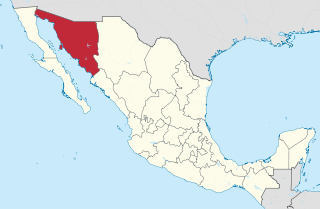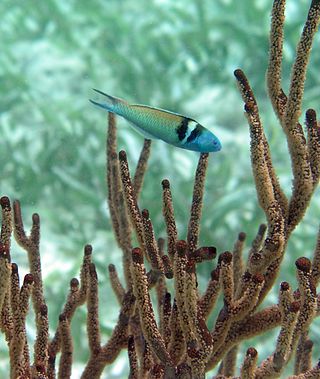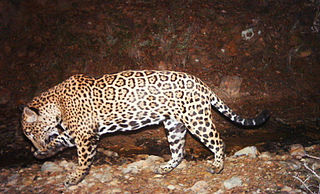
The jaguar is a large cat species and the only living member of the genus Panthera native to the Americas. With a body length of up to 1.85 m and a weight of up to 158 kg (348 lb), it is the largest cat species in the Americas and the third largest in the world. Its distinctively marked coat features pale yellow to tan colored fur covered by spots that transition to rosettes on the sides, although a melanistic black coat appears in some individuals. The jaguar's powerful bite allows it to pierce the carapaces of turtles and tortoises, and to employ an unusual killing method: it bites directly through the skull of mammalian prey between the ears to deliver a fatal blow to the brain.
A black panther is the melanistic colour variant of the leopard and the jaguar. Black panthers of both species have excess black pigments, but their typical rosettes are also present. They have been documented mostly in tropical forests, with black leopards in Kenya, India, Sri Lanka, Nepal, Thailand, Peninsular Malaysia and Java, and black jaguars of the Americas in Mexico, Panama, Costa Rica, Brazil and Paraguay. Melanism is caused by a recessive allele in the leopard, and by a dominant allele in the jaguar.

The cougar is a large cat native to the Americas. Its range spans from the Canadian Yukon to the southern Andes in South America and is the most widespread of any large wild terrestrial mammal in the Western Hemisphere. It is an adaptable, generalist species, occurring in most American habitat types. This wide range has brought it many common names, including puma, mountain lion, catamount and panther. It is the second-largest cat in the New World, after the jaguar. Secretive and largely solitary by nature, the cougar is properly considered both nocturnal and crepuscular, although daytime sightings do occur. Despite its size, the cougar is more closely related to smaller felines, including the domestic cat than to any species of the subfamily Pantherinae.

Sonora, officially Estado Libre y Soberano de Sonora, is one of the 31 states which, along with Mexico City, comprise the Federal Entities of Mexico. The state is divided into 72 municipalities; the capital city of which being Hermosillo, located in the center of the state. Other large cities include Ciudad Obregón, Nogales, San Luis Río Colorado, and Navojoa.

The Gulf of California, also known as the Sea of Cortés or Sea of Cortez, or less commonly as the Vermilion Sea, is a marginal sea of the Pacific Ocean that separates the Baja California Peninsula from the Mexican mainland. It is bordered by the states of Baja California, Baja California Sur, Sonora, and Sinaloa with a coastline of approximately 4,000 km (2,500 mi). Rivers that flow into the Gulf of California include the Colorado, Fuerte, Mayo, Sinaloa, Sonora, and the Yaqui. The surface of the gulf is about 160,000 km2 (62,000 sq mi). Maximum depths exceed 3,000 meters (9,800 ft) because of the complex geology, linked to plate tectonics.

Hermosillo, formerly called Pitic, is a city located in the center of the northwestern Mexican state of Sonora. It is the municipal seat of the Hermosillo municipality, the state's capital and largest city, as well as the primary economic center for the state and the region. As of 2020, the city has a population of 936,263, making it the 18th largest city in Mexico. The recent increase in the city's population is due to expanded industrialization, especially within the automotive industry.

The Sonoran Desert is a desert in North America and ecoregion that covers the northwestern Mexican states of Sonora, Baja California, and Baja California Sur, as well as part of the southwestern United States. It is the hottest desert in both Mexico and the United States. It has an area of 260,000 square kilometers (100,000 sq mi).

The Sierra Madre Occidental is a major mountain range system of the North American Cordillera, that runs northwest–southeast through northwestern and western Mexico, and along the Gulf of California. The Sierra Madre is part of the American Cordillera, a chain of mountain ranges (cordillera) that consists of an almost continuous sequence of mountain ranges that form the western 'sounds' of North America, Central America, South America, and West Antarctica.

The Sierra Madre Occidental pine–oak forests are a Temperate broadleaf and mixed forests ecoregion of the Sierra Madre Occidental range from the southwest USA region to the western part of Mexico. They are home to a large number of endemic plants and important habitat for wildlife.

The North American cougar is a cougar subspecies in North America. It is the biggest cat in North America, with North American jaguars being fairly small. It was once common in eastern North America, and is still prevalent in the western half of the continent. This subspecies includes populations in western Canada, the western United States, Florida, Mexico and Central America, and possibly South America northwest of the Andes Mountains. It thus includes the extirpated Eastern cougar and extant Florida panther populations.

Alan Robert Rabinowitz was an American zoologist who served as the president, CEO, and chief scientist at Panthera Corporation, a nonprofit conservation organization devoted to protecting the world's 40 wild cat species. Called the "Indiana Jones of Wildlife Protection" by Time, he studied jaguars, clouded leopards, Asiatic leopards, tigers, Sumatran rhinos, bears, leopard cats, raccoons, and civets.

Since declaring independence in 1981, Belize has enacted many environmental protection laws aimed at the preservation of the country's natural and cultural heritage, as well as its wealth of natural resources. These acts have established a number of different types of protected areas, with each category having its own set of regulations dictating public access, resource extraction, land use and ownership.

Mapastepec is a town and municipality in the southeastern state of Chiapas, Mexico. Its name derives from the place name mapachtepec, "Hill of the Raccoon", a compound of the Nahuatl words mapachi ("raccoon") and tepetl ("mountain").

Puerto Peñasco Municipality is a municipality in Sonora in north-western Mexico. As of 2015, the municipality had a total population of 62,177 inhabitants. The only locality with a significant population is the municipal seat, also named Puerto Peñasco, which contains almost 99% of the municipality's population.

The El Cielo Biosphere Reserve is located in the Sierra Madre Oriental in the southern part of the Mexican state of Tamaulipas near the town of Gómez Farias. The reserve protects the northernmost extension of tropical forest and cloud forest in Mexico. It has an area of 144,530 hectares made up mostly of steep mountains rising from about 200 metres (660 ft) to a maximum altitude of more than 2,300 metres (7,500 ft).

El Jefe is an adult, male North American jaguar that was seen in Arizona. He was first recorded in the Whetstone Mountains in November 2011, and was later photographed over several years in the Santa Rita Mountains. From November 2011 to late 2015, El Jefe was the only wild jaguar verified to live in the United States since the death of Arizona Jaguar Macho B in 2009. According to "Notes on the Occurrences of Jaguars in Arizona and New Mexico", an article regarding jaguars in the Southwest US, "Sixty two jaguars have been reportedly killed or captured in the American Southwest since 1900." He was not seen in Arizona after September 2015 and it was presumed that he returned to Mexico, where the nearest breeding population of jaguars is located. This was confirmed almost seven years later in August 2022, when a collective of conservation groups announced that he had been photographed using a motion-detecting camera, on November 27, 2021, in the central part of the state of Sonora.

The North American jaguar is a jaguar population in North America, ranging from the Southwestern United States to Central America. This population has declined over decades and was almost extirpated from the United States by 1960.

The Sierra de Álamos–Río Cuchujaqui Flora and Fauna Protection Area, also known as the Sierra de Álamos–Río Cuchujaqui Biosphere Reserve, is a protected area and biosphere reserve in western Mexico. It is located in southeastern Sonora state, along the boundary with Sinaloa and Chihuahua states.
Bavispe Flora and Fauna Protection Area is a protected area in the state of Sonora in northwestern Mexico.

La Sepultura is a biosphere reserve in southern Mexico. It protects a portion of the Sierra Madre de Chiapas range in the state of Chiapas.

















